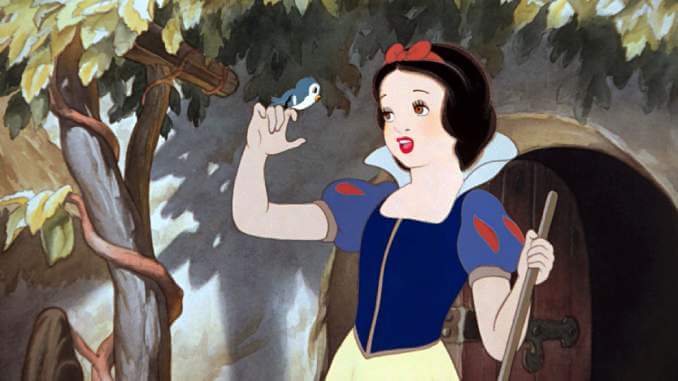Walt Disney’s Century: Snow White and the Seven Dwarfs
Hollywood's first feature-length cel animated film gave the world the Disney Princess

This year, The Walt Disney Company turns 100 years old. For good or ill, no other company has been more influential in the history of film. Walt Disney’s Century is a monthly feature in which Ken Lowe revisits the landmark entries in Disney’s filmography to reflect on what they meant for the Mouse House—and how they changed cinema. You can read all the entries here.
My mother was born in Cuba in the 1950s. She remembers a lot of stuff from her time there that sounds strange to me, but our childhoods share one thing, if you can believe it: The first movie we ever saw in a movie theater was the same one. It was Snow White and the Seven Dwarfs, the first feature-length, cel animated film. Released in 1937, it must’ve played some movie house on Isla de Pinos for a few pesos a seat in the last days of capitalism. It re-released for a big golden anniversary theatrical run in the United States in 1987, when I was three.
That’s the power of Disney, I guess: On the other end of fleeing from a Communist dictatorship, years after gaining fluency in English and U.S. naturalization, and after having two kids, the same damn movie was there waiting for my mom to take her kids to. Convenient!
This column on Disney movies of the past century isn’t just going to be about their animated features—the company has done so much in so many places, and you don’t need to hear more about how Hercules is, in the most charitable way I can state it, a work that doesn’t even understand why it is this close to being white Christian dominionist garbage (albeit with solid 7/10 songs). But Snow White and the Seven Dwarfs demands to be revisited. It signaled what the Walt Disney Company became in the handful of decades before the theme parks and the television purchases—before becoming the many-headed beast it’s become today.
The company started with a mouse, but with Snow White, it became the home of princesses.
There’s not much you can do to make a story that takes a breezy five minutes to read aloud to sleepy children fill an entire feature-length runtime, but one way is to make it a musical, which was Disney’s stock in trade at the time. But where Disney’s old shorts that ran in theaters were elastic affairs in which Mickey and the gang bent their bodies around and acted like, well, cartoon characters, you immediately see that Snow White is not the same kind of show.
Snow White and the Seven Dwarfs is edited and composed in the style of a film from the Golden Age of Hollywood. The camera mostly pans and widens and tightens the way it would if it existed on a physical set, and the “sets” themselves look only very slightly exaggerated in most scenes so that it’s all the more effective when the film does go the route of being completely fantastical: A forest of distorted creatures made real by Snow White’s fear of the dark; a witch’s dungeon; a golden castle above the clouds.
The animation on display certainly does exaggerate and distort sometimes, but that’s not really what the animators are there to do: The goal here is to create cute woodland creatures, pounding rain, crashing lightning and the realistic movement of a woman dancing and singing that looks as if it absolutely must have been modeled on someone in real life twirling her dress in joy.
The story is pretty close to the Grimm version: Snow White’s evil stepmother, the queen, can’t abide the child being more beautiful, so she puts a hit out on her that Snow White escapes from, because she is too pretty to kill. The dwarfs take pity on her and she signs up to be their housekeeper in exchange for food and lodging and two or three musical numbers with them (one of them is pretty okay). The queen disguises herself as a hag peddling apples and tricks the girl into eating a poisoned one. The dwarfs believe her to be dead, but the girl is merely pinin’ for the fjords and awakens when a prince kisses her.
It sounds simple because it is, but it’s all animated as lavishly as anything that’s ever been done in the history of the medium: Beasts and fowl move like they’re real, even though they’re given anthropomorphized expressions and characterization. Rain lashes the mountainside as the dwarfs pursue the transformed queen to a final confrontation. It’s captivating because nobody does cel animation anymore. The art form is this close to simply being lost forever, if it hasn’t already been. It’s unlikely there will ever be another movie that looks like Snow White and the Seven Dwarfs, because it could only ever be made by a massive studio, and no massive studio will ever bother using these traditional techniques again when their animators can use touchpads and A.I.-assisted in-betweeners, when they don’t use 3D imagery that’s fully computer generated.
-

-

-

-

-

-

-

-

-

-

-

-

-

-

-

-

-

-

-

-

-

-

-

-

-

-

-

-

-

-

-

-

-

-

-

-

-

-

-

-








































